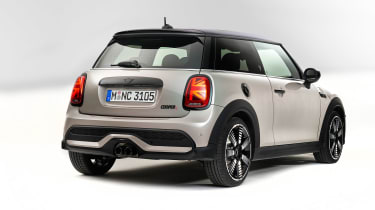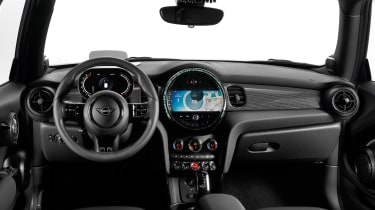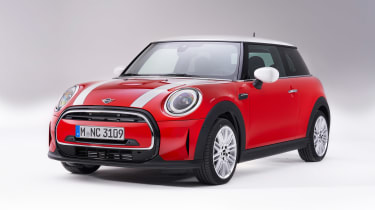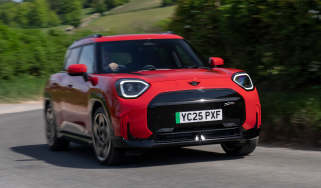Mini range updated for 2021 – supermini sharpens up to rival A1 and new 500e
The Mini hatch range, including the Cooper S and Mini Electric all gain new style and tech features
Mini has revealed its updated 2021 hatchback range, with the Cooper, Cooper S and Mini Electric all receiving a new look inside and out. The current-generation F55 Mini hatchback has been with us since 2013, and despite being subject to a subtle facelift in 2017, will continue to live on in this further updated form, rather than undergoing the total overhaul you might expect at the end of a traditional seven-year life cycle.
The changes outside are subtle but obvious, dominated by a new nose that features a cleaner and more contemporary set of graphics that continue to reference Frank Stephenson’s 2001 original. Gone, for the most part, are the Mini’s multiple lighting elements and use of chrome brightwork, replaced now with a dramatic grille that extends the whole way down the front fascia, encompassing grilles, intakes and the number plate housing. Outside of this hoop of gloss black are inlets for the air-curtains that draw air around the front wheels. The standard LED headlights now feature Mini JCW GP-like black innards as standard, likewise an optional black badging package.
The contrasting wheel arch surrounds, long a Mini trademark, have been reprofiled, so too the side repeater and rear fog lights which have been replaced with slim LED units. Around at the rear, a similar treatment has been applied to the rear bumper as the front, with a hooped section of gloss black encompassing the exhaust and other design elements. The controversial Union Jack rear lights remain, albeit slightly tinted in some models in a theme again drawn from the GP.
Inside the changes are more subtle, with a standard fitment of the new instrument cluster found in the Mini Electric and JCW GP, fresh infotainment graphics (although the aging UI is largely the same) and a new passenger-side trim insert now encompassing the air-vent. Across both the exterior and interior, Mini has also freshened up the colour and trim options, with no less than five new wheel designs, and a graduated roof colour option.
Under the skin the new Mini is almost entirely unchanged, featuring the same range structure and two engine options: a 1.5-litre turbocharged three-cylinder, and the ubiquitous B48 2-litre turbocharged four-cylinder petrol. Each is available in two outputs, topping out with the 231bhp John Cooper Works. New to the options list are active variable rate dampers, attached to the Mini’s typical Macpherson strut front and multilink rear suspension designs.
The Mini Electric will pick up all the new Mini’s changes wholesale, and maintain its tiered range structure. These updates also apply to the five-door Mini and Mini Cabriolet models.
Mini’s decision to deviate from the traditional seven-year model cycle by giving the current generation model a second update, rather than fully-redesigning it, is due to Mini’s plans for the next generation model. For this new model, the brand is expected to move away from the current BMW-derived platform and onto a new one that will allow the next generation to shrink from its current proportions and more profitably integrate an EV powertrain. Whether this platform will come directly from BMW as now, or be derived from other external partnerships remains to be seen, but the extent of this facelift does tell us that we still have a fair wait before that next-generation Mini arrives.








